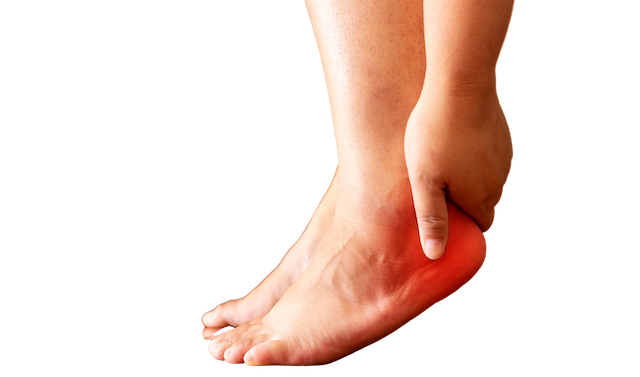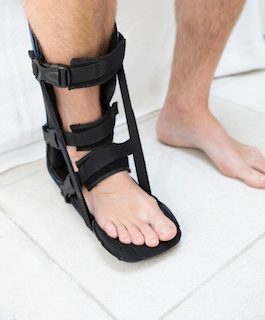Physio Hub:
Evidence-Based Article
Understanding and Self-Managing Plantar Fasciitis

< Key Points >
-
Self-Management: Use rest, cold/heat treatments, orthotic supports, and specific stretching exercises for relief from plantar fasciitis.
-
Stretching and Night Splints: Regular stretching of the calf and plantar fascia, along with the use of night splints, are effective in managing symptoms.
-
Professional Guidance: Consult healthcare professionals for personalized treatment plans and management, especially in cases of persistent symptoms.
Plantar Fasciitis is a prevalent foot condition that manifests as sharp pain in the heel and arch. This discomfort arises from the inflammation of the plantar fascia, a robust tissue band at the foot’s base, linking the heel bone to the toes. The condition frequently affects runners, overweight individuals, and those who wear poorly supportive footwear, due to increased strain on the plantar fascia. Understanding the etiology of this condition is crucial, as it often results from repetitive stress and overuse, leading to micro-tears in the tissue. Identifying risk factors such as flat feet, high arches, abnormal walking patterns, and prolonged standing can also be instrumental in both prevention and management. The pain, typically worse in the morning, can severely impact daily activities, making early diagnosis and management imperative for quality of life.
Self-Management Strategies and Advanced Interventions
Effectively self-managing plantar fasciitis is paramount and involves a multifaceted approach. Initial steps include reducing activities that exacerbate the condition, such as prolonged standing or running. Implementing cryotherapy (cold treatment) and heat therapy can aid in reducing inflammation and alleviating pain. Orthotic devices like heel cups and specialized cushions provide crucial support and cushioning, redistributing pressure away from the inflamed area. Modifying daily activities to minimize continuous strain and incorporating rest periods can prevent aggravation of the condition. Over-the-counter nonsteroidal anti-inflammatory drugs (NSAIDs) can be utilized for pain relief and inflammation reduction. Stretching exercises targeting the Achilles tendon and plantar fascia are essential for tension relief. For more severe cases, advanced interventions like night splints, which maintain the foot in a dorsiflexed position during sleep, can aid in stretching the plantar fascia and alleviating morning pain. Physical therapy plays a vital role, with therapists guiding patients through specific exercises and potentially employing additional modalities like ultrasound therapy or soft tissue massage to enhance healing. These interventions, combined with a clear understanding of the condition, enable a holistic approach to managing plantar fasciitis.
Effective Stretching Techniques and Professional Support
The cornerstone of plantar fasciitis management is stretching, vital for symptom alleviation. Stretching exercises should be performed with consistency and gentleness to avoid exacerbating the condition. Key exercises include calf stretches, which involve standing facing a wall, placing the affected leg behind, and leaning forward while keeping the heel grounded. This stretches the calf muscles and indirectly the plantar fascia. Plantar fascia-specific stretches involve sitting and pulling the toes towards the shin, creating a stretch along the foot’s arch. Additionally, towel stretches, performed before getting out of bed, involve looping a towel around the affected foot and gently pulling it towards oneself, keeping the knee straight. These exercises, done multiple times daily, can significantly reduce pain and improve foot functionality. Beyond self-care, seeking professional support is crucial, especially in persistent or complicated cases. Physical therapists can offer tailored exercise regimes and hands-on therapy, while podiatrists provide specialized footwear advice and custom orthotics. Patients with diabetes require careful monitoring due to an increased risk of foot complications. Educating patients about their condition, the role of each treatment modality, and the importance of regular exercise and proper footwear is a key aspect of comprehensive care.
Navigating Recovery and Seeking Timely Intervention
Recovering from plantar fasciitis can be a protracted process, generally spanning several weeks to months. Consistency in applying self-management techniques is critical for effective healing. Lifestyle modifications play a significant role in this journey, including weight management to reduce foot strain and choosing appropriate, supportive footwear to prevent recurrence. If symptoms persist or worsen, it’s imperative to seek professional medical assessment to explore additional interventions, such as imaging studies, alternative therapies, or in rare cases, surgical options. Open communication with healthcare providers allows for a tailored treatment plan, addressing individual needs and ensuring a thorough understanding of the condition. It’s important for patients to recognize that recovery is a journey, often requiring patience and adherence to prescribed management plans. With the right combination of diligent self-care, professional guidance, and lifestyle adjustments, individuals can effectively manage their symptoms and regain their quality of life, returning to daily activities free from pain.
< Reference >
- Buchbinder R. Plantar Fasciitis. N Engl J Med. 2004;350(21):2159-2166. doi:10.1056/NEJMcp032745
- Hossain M, Makwana N. “Not Plantar Fasciitis”: the differential diagnosis and management of heel pain syndrome. Orthop Trauma. 2011;25(3):198-206. doi:10.1016/j.mporth.2011.02.003
- Gibbon WW, Long G. Ultrasound of the plantar aponeurosis (fascia). Skeletal Radiol. 1999;28(1):21-26. doi:10.1007/s002560050467
- Riddle DL, Pulisic M, Pidcoe P, Johnson RE. RISK FACTORS FOR PLANTAR FASCIITIS: A MATCHED CASE-CONTROL STUDY. J Bone Jt Surg-Am Vol. 2003;85(5):872-877. doi:10.2106/00004623-200305000-00015
- van Leeuwen KDB, Rogers J, Winzenberg T, van Middelkoop M. Higher body mass index is associated with plantar fasciopathy/‘plantar fasciitis’: systematic review and meta-analysis of various clinical and imaging risk factors. Br J Sports Med. 2016;50(16):972-981. doi:10.1136/bjsports-2015-094695
- Lopes AD, Hespanhol LC, Yeung SS, Costa LOP. What are the Main Running-Related Musculoskeletal Injuries?: A Systematic Review. Sports Med. 2012;42(10):891-905. doi:10.1007/BF03262301
- Menz HB, Thomas MJ, Marshall M, et al. Coexistence of plantar calcaneal spurs and plantar fascial thickening in individuals with plantar heel pain. Rheumatology. 2019;58(2):237-245. doi:10.1093/rheumatology/key266
- Moroney PJ, O’Neill BJ, Khan-Bhambro K, O’Flanagan SJ, Keogh P, Kenny PJ. The Conundrum of Calcaneal Spurs: Do They Matter? Foot Ankle Spec. 2014;7(2):95-101. doi:10.1177/1938640013516792
- Jessup RL, Oates MJ, Johnston RV, Buchbinder R. Shockwave therapy for plantar heel pain (plantar fasciitis). Cochrane Musculoskeletal Group, ed. Cochrane Database Syst Rev. Published online November 25, 2019. doi:10.1002/14651858.CD013490
- Lemont H, Ammirati KM, Usen N. Plantar Fasciitis. J Am Podiatr Med Assoc. 2003;93(3):234-237. doi:10.7547/87507315-93-3-23411.
- Morrissey D, Cotchett M, Said J’Bari A, et al. Management of plantar heel pain: a best practice guide informed by a systematic review, expert clinical reasoning and patient values. Br J Sports Med. 2021;55(19):1106-1118. doi:10.1136/bjsports-2019-101970


